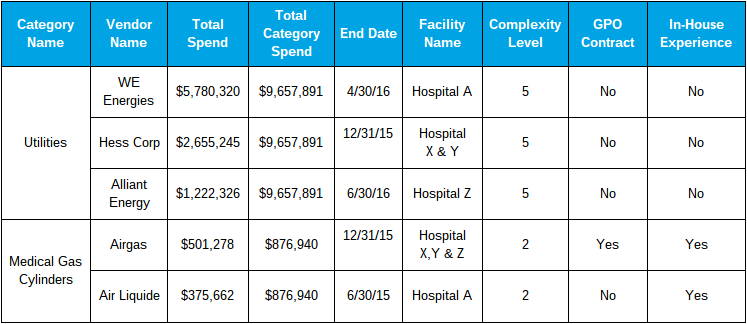Well, it’s the beginning of a new year and you are either starting a new fiscal year or partially through your 2015 budget already. For those that are just starting a new budget cycle, I am wondering how you are currently prioritizing what your team will work on this year. How are you going to reach your purchased services savings goal? If you’re like my previous employers, your process is to simply divide your team’s contracting time based on which department is complaining the most. This is also called the squeaky wheel approach. This is an effective method if your primary goal is to keep people off your back, but if you want to maximize your team’s efficiency and get the biggest bang for your buck, you will need to act more strategically this year.

A lot of times, healthcare supply chain executives will fill their contracting plan up with renewals for agreements that are expiring this year and maybe send out a few RFPs for some categories. While you obviously have to do something with those expiring agreements, it’s typically not the best idea to simply extend them due to lack of time and/or resources. Since you are most likely not going to receive any new full time employees this year, you need a better way to manage your contracting obligations.
Some of you might be thinking, “I don’t have to worry about this because my GPO handles these tasks for me.” True, sometimes they do if you outsourced this to them already. But how do you know you are getting the best deal possible and not just getting moved onto one of their contracts because it’s in their best interest? Almost all GPOs have a very weak purchased services portfolio, so they are probably not contracting for the majority of your needs in this space. You really need to have a way to monitor what’s going on within your contracts across all of your facilities.
Best Practices for Building Your Purchased Services Work Plan
The only way to know you are maximizing the output of your contracting teams’ efforts is to know exactly how much you are spending on each purchased services category across your entire health system. Once you have that information, follow these steps to maximize your team’s output:
Step 1: Sort the categories by annual volume.
Step 2: Start with the top category and collect the important details like:
-
The name of the vendors being used for each category
-
The total spend with each vendor for that category
-
The current end date of each vendors agreement
-
The facility names that are using this vendor for that category
-
How complex do you think this category will be to complete (scale 1-5)?
-
Is this vendor on a GPO contract?
-
Does your team have experience to negotiate and/or run an RFP on their own?
The end result will look something like this:

This spreadsheet will continue for dozens more categories. As a reference, Valify has about 1,000 different Purchased Services categories in our database and the average hospital has about 230 unique purchased services categories they manage each year.
After you have captured all of this information, here are the remaining steps I recommend taking:
Step 3: Start the process of extending the individual contracts within a category so that they all have the same end date.
Step 4:Once all contracts are extended to the same end date, you should look at the categories with the earliest end date and determine if you have the expertise to handle it appropriately in-house or not.
Step 5:Assign all of the categories that members of your team have experience in to their work plans.
Step 6: For the other categories, you should start reaching out to your GPO and consultants to see if they have the experience you need.
By starting with a combination of total spend and an end date, you will maximize the output of your team each year. You will also be able to plan/budget your consulting dollars appropriately for the next year or two. This might not stop that squeaky wheel from wanting you to work on their pet project, but it will definitely give you an easily defensible reason you can show them. Just point out that their project is number 125 on the list.
image source: istock

